|
 Squamanita squarrulosa Squamanita squarrulosa
BiostatusPresent in region - Indigenous. Endemic
Images (click to enlarge)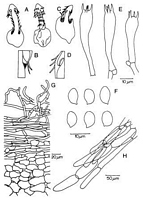
Caption: Fig. 1 Squamanita squarrulosa. - PDD 49071: A. Habit and longitudinal section (x 1);
B. Detail of pileus margin (x 5); E. Basidia; F. Spores; G. Section through pellis of
tuber; H. Hyphae from squamule on pileus. - PDD 49072: C. Longitudinal section of
| 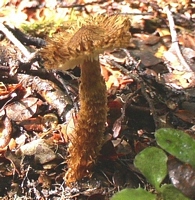
Owner: G. Monk | 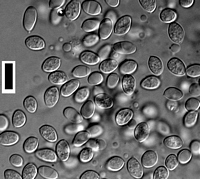
Caption: scale = 10um. Spores
Owner: J.A. Cooper | 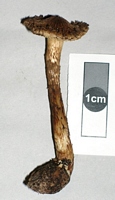
Owner: J.A. Cooper | 
Owner: G. Monk | 
Owner: G. Monk | 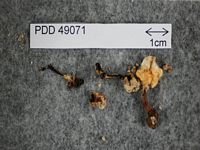
Caption: Dried type specimen
Owner: Herb PDD |
Article: Ridley, G.S. (1988). Squamanita squarrulosa, a new species from New Zealand. Persoonia 13(4): 459-462.
Description: Basidiocarps solitary. Pileus 4-9 mm wide, conical, sienna-umber (Rayner 8-9), dry
squarrose, in immature basidiocarps pileus and upper part of stipe sheathed by a buff
(Rayner 45) tissue layer beneath the pileal squamules that disappears with maturation.
Lamellae adnexed, moderately crowded, white, intercalated with lamellulae; edge
concolorous, entire. Stipe 25 x 5 mm, narrowing slightly at apex, solid, concolorous
with pileus, squamulose; squamules narrow and erect, particularly crowded between
base of stipe and volval limb. Protocarpic tuber 16-19 mm wide and 20-26 mm
high, whitish with pale vinaceous to vinaceous flush (Rayner 85 to 57), smooth,
firm, partially buried in humus, surmounted by a fleshy, sheathing volva, tearing
irregularly and forming a 4-5 mm deep cup. Context of pileus white, 4 mm thick
at centre, firm, fibrillose. Context of tuber pithy, white with some vinaceous
stains (Rayner 57), distinct from the fibrillose context of stipe.
Spores 7.5-8.5 x 4.5-6 µm, ellipsoid to elongate-ellipsoid, with small apiculus,
thin-walled, smooth, hyaline, inamyloid, not metachromatic in Cresyl Blue, not
accumulating Congo Red. Basidia 4-spored, 37-50 x 8.5-10.5 µm, clavate, with
basal clamp. Cystidia absent. Trama of lamellae regular, made up of hyphae 8-12
µm wide, narrowing in subhymenium to 3-6 µm wide, hyaline; walls appearing
very finely verrucose; clamps abundant. Squamules on pileus and stipe consisting
of hyphae 10-25 µm wide and up to 120 µm long, sienna (Rayner 8), constricted at
septa, with indistinctly verrucose walls. Pileipellis structure similar to that of
squamules. Protocarpic tuber: suprapellis composed of loosely intertwinted
hyphae 2.5-6 µm wide, hyaline, often with subseptal swelling, no clamps
observed: subpellis similar to suprapellis but hyphae repent and parallel; trama
cellular; cells up to 45 µm diam. and hyaline.
Habitat: Under Nothofagus truncata.
Distribution: Known only from type locality, southern North Island, New Zealand.
Notes: Squamanita squarrulosa possesses a distinct, fleshy, outer universal veil which is
continuous with the protocarpic tuber, and forms the pronounced limbate volva
when ruptured. The pileus and upper stipe are covered by squamules subtended by
a buff tissue layer (Fig. 1D). Before stipe elongation this buff layer may be
connected to the protocarpic tuber. As the pileus expands this tissue becomes
confined to it, and finally disappears. In the angle between the outer universal veil
and the stipe are a number of erect squamules, which as the stipe elongates,
become distributed along its length. Thus the inner universal veil can be
interpreted as consisting of two parts. The first part is the outer squarrose layer,
which becomes distributed over the mature pileus and stipe. The second part
consists of the inner buff layer covering the basidiocarp primordium, which in the
expanding basidiocarp, becomes indiscernible. The two layers combined are
interpreted as homologous with the tawny yellow layer of S. tropica (Bas, 1965).
In the most mature basidiocarp the margin of the pileus is connected to the stipe
by a small amount of fibrous tissue (Fig. 1B). Whether this can be interpreted as
an independent partial veil or merely a remnant of the inner universal veil is not
clear.
|